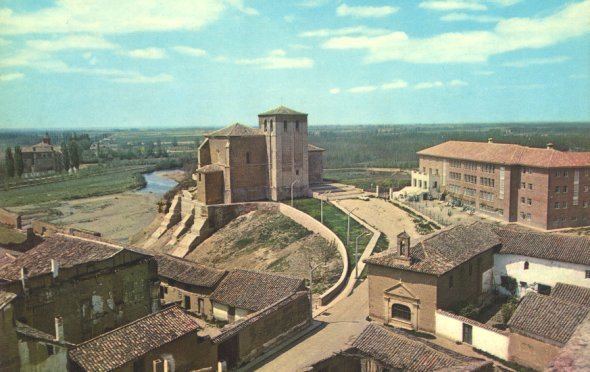Died 1134 | ||
 | ||
Beltrán or Bertrán de Risnel (English: Bertrand, Latin: Beltranus; floruit 1113–34) was an Aragonese political and military figure during the reign of Alfonso the Battler, who was his nephew or cousin. Beltrán was mainly active in the kingdoms of León and Castile, which Alfonso co-ruled for a time with his wife, Queen Urraca. He received Leonese titles and governed territories in León and Castile on behalf of the crown. He only sporadically attended the court of either King Alfonso or Queen Urraca, but he sometimes acted as a go-between. He became progressively more involved to Leonese court politics.
Contents
Acquisition of power in Castile–León
Beltrán may have been a younger son of Count Raymond IV of Toulouse by his wife Elvira of Castile. He arrived in Castile in 1113, perhaps together with two Occitan magnates—Aimery II of Narbonne and Ermengol VI of Urgell—in the following of Pedro González de Lara, then the lover of Queen Urraca and enemy of Alfonso. He had recently returned from an exile in the County of Barcelona after being besieged by Alfonso in Monzón. More probably he came in the entourage of Alfonso, who appointed governor of Carrión de los Condes in that year. The county of Carrión under Beltrán did not corresponded in extension to the same county held by Pedro Ansúrez during the reign of Alfonso VI. This county lay along the River Carrión from Saldaña to twenty-five kilometres south and along the Way of Saint James for thirty kilometres until Melgar de Fernamental in the east. It is unclear from contemporary records whether these lands formed a part of Castile or the Campo Gótico, which was a region of León. From 1113 they were effectively under the control of Alfonso the Battler. Beltrán's county did not include Saldaña, which was ruled by Pedro Ansúrez until the end of 1117 and by Pedro López de Monforte afterwards (at least from November 1119 until March 1125).
Between 1113 and 1115 Beltrán was with the court of Urraca, regularly employing the title "count", perhaps as a courtesy to a foreigner. He was probably negotiating with the queen on behalf of Alfonso as late as 13 March 1115, when he subscribed a charter of hers. By late April Alfonso had come to Sahagún to meet personally with the queen, both his wife and his rival. The king placed him in command of the city and forced the abbot to make peace with him. He was also appointed governor of Logroño. In 1116 Beltrán was holding Monzón.
Church affairs and marriage
In February 1117 the synod of Burgos appointed Beltrán assertor (advocate) of the exiled inhabitants of Sahagún in a lawsuit against the monks of the local monastery heard before the Archbishop of Toledo, Bernard. The synod also made bishops Hugh of Oporto and Pascal of Burgos responsible for the satisfaction of the monks claims against the burghers and for the return of the latter to their homes. This is representative of peace between Alfonso and Urraca, as the former was accepting Pascal as bishop of Burgos and the latter recognised Beltrán as legitimate count of Carrión. In 1119 Beltrán was again present at the queen's court, possibly throughout the attempted coup of Gutierre Fernández in July. On 8 October Beltrán and Pedro Fróilaz de Traba witnessed a charter of the young heir and co-regent, Alfonso VII, for the monastery of Sahagún. Beltrán confirmed two more charters of Alfonso VII during Urraca's reign: on 1 November 1124 and 19 January 1125.
Beltrán's marriage, probably in 1128/9, to Elvira Pérez, illegitimate daughter of Queen Urraca and Pedro González de Lara, was arranged by the Emperor Alfonso VII. Elvira, born towards 1113, was perhaps already a widow. At the time of their marriage, which had taken place sometime before 1130, Alfonso granted Elvira the vills of Nogal and Olmillos, located on the Way of Saint James in northern Castile. In January 1168 Elvira donated the vills to the monastery of Sahagún in León. No children are recorded of Beltrán and Elvira, but a certain María Beltrán who married Íñigo Jiménez de Lara as his second wife may have been a daughter of Beltrán by a previous relationship.
Revolt and death
In 1127, after the Peace of Támara, Alfonso VII made Beltrán the governor of Burgos. In 1130 the House of Lara, with whom Beltrán was attached through marriage, rose in revolt against the Emperor in favour of installing Elvira's brother, Fernando Pérez de Lara, on the throne. With his father-in-law Beltrán captured the city of Palencia (or perhaps Palenzuela). In June the Emperor besieged Palencia/Palenzuela, capturing Pedro and forcing Beltrán to negotiate. The Chronica Adefonsi imperatoris (I, §18), which accuses of Pedro and Beltrán of "causing much disorder in the kingdom", records that they were put in chains in prison in the city of León until they had surrendered all their castles and cities. Although initially disgraced, after his release he continued to subscribe royal charters down to 1133, although he was never resident at Alfonso VII's court. As late as 1131 he was still holding Castrojeriz.
Beltrán joined the Battler's final military expedition, the Battle of Fraga, where both he and the king died in battle (1134). Beltrán's posthumous reputation can be gauged from line 3004 of the Poema de mio Cid, written towards the year 1200. There he is placed in the second tier of nobility, immediately beneath Alfonso VI, Henry of Portugal, and Raymond of Galicia, and beside Fruela Díaz. This is the beginning of the ahistorical "Cortes de Carrión" passage. Beltrán had nothing to do with any of these other figures, but he was connected with the event through his rule of Carrión and through his familial relations with the Lara, probably patrons of the Mio Cid poet:
